TOYOTA GR SUPRA 2022 Owners Manual
Manufacturer: TOYOTA, Model Year: 2022, Model line: GR SUPRA, Model: TOYOTA GR SUPRA 2022Pages: 356, PDF Size: 39.14 MB
Page 161 of 356
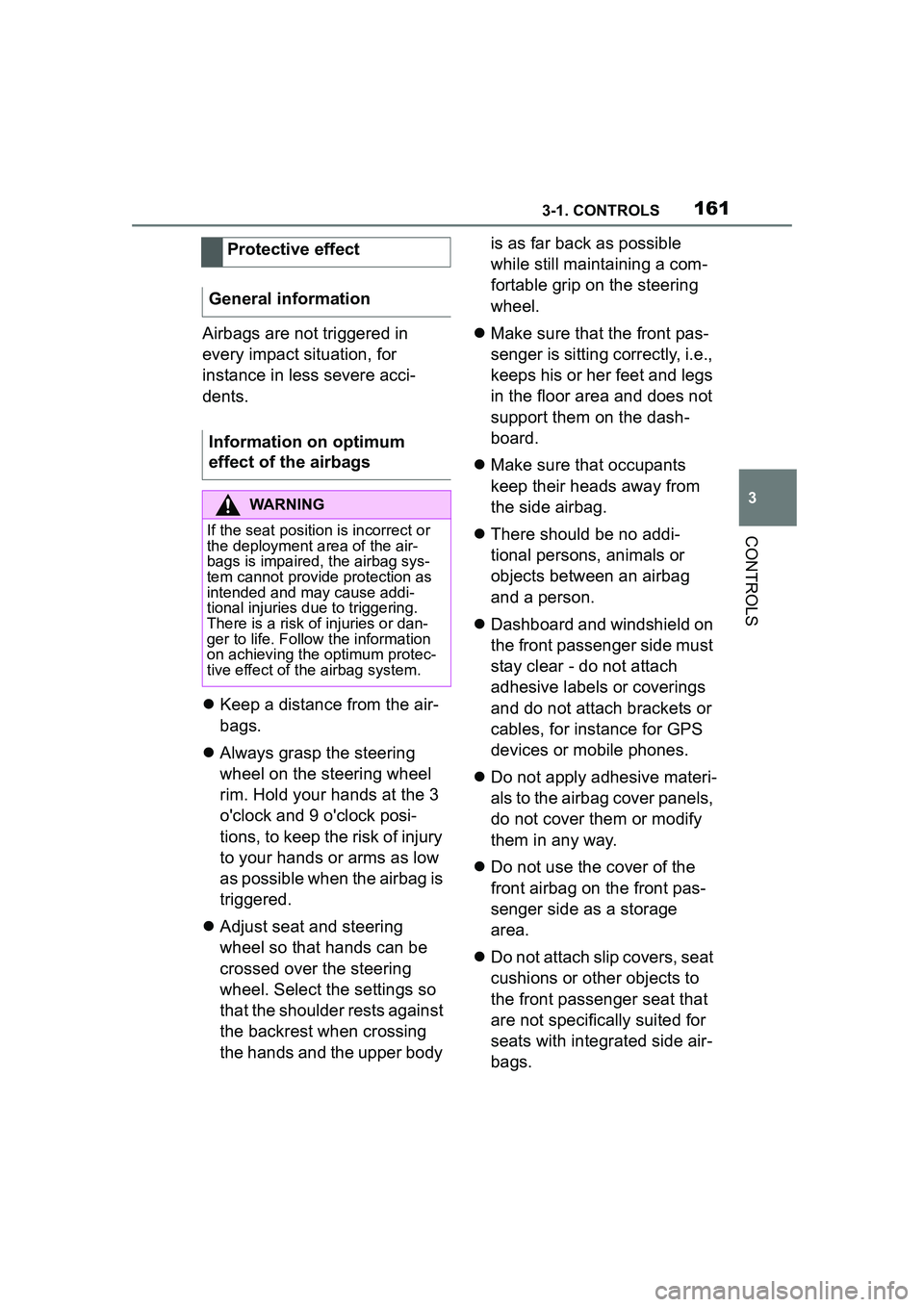
1613-1. CONTROLS
3
CONTROLS
Airbags are not triggered in
every impact situation, for
instance in less severe acci-
dents.
Keep a distance from the air-
bags.
Always grasp the steering
wheel on the steering wheel
rim. Hold your hands at the 3
o'clock and 9 o'clock posi-
tions, to keep the risk of injury
to your hands or arms as low
as possible when the airbag is
triggered.
Adjust seat and steering
wheel so that hands can be
crossed over the steering
wheel. Select the settings so
that the shoulder rests against
the backrest when crossing
the hands and the upper body is as far back as possible
while still maintaining a com-
fortable grip on the steering
wheel.
Make sure that the front pas-
senger is sitting correctly, i.e.,
keeps his or her feet and legs
in the floor area and does not
support them on the dash-
board.
Make sure that occupants
keep their heads away from
the side airbag.
There should be no addi-
tional persons, animals or
objects between an airbag
and a person.
Dashboard and windshield on
the front passenger side must
stay clear - do not attach
adhesive labels or coverings
and do not attach brackets or
cables, for instance for GPS
devices or mobile phones.
Do not apply adhesive materi-
als to the airbag cover panels,
do not cover them or modify
them in any way.
Do not use the cover of the
front airbag on the front pas-
senger side as a storage
area.
Do not attach slip covers, seat
cushions or other objects to
the front passenger seat that
are not specifically suited for
seats with integrated side air-
bags.
Protective effect
General information
Information on optimum
effect of the airbags
WARNING
If the seat position is incorrect or
the deployment area of the air-
bags is impaired, the airbag sys-
tem cannot provide protection as
intended and may cause addi-
tional injuries due to triggering.
There is a risk of injuries or dan-
ger to life. Follow the information
on achieving the optimum protec-
tive effect of the airbag system.
Page 162 of 356
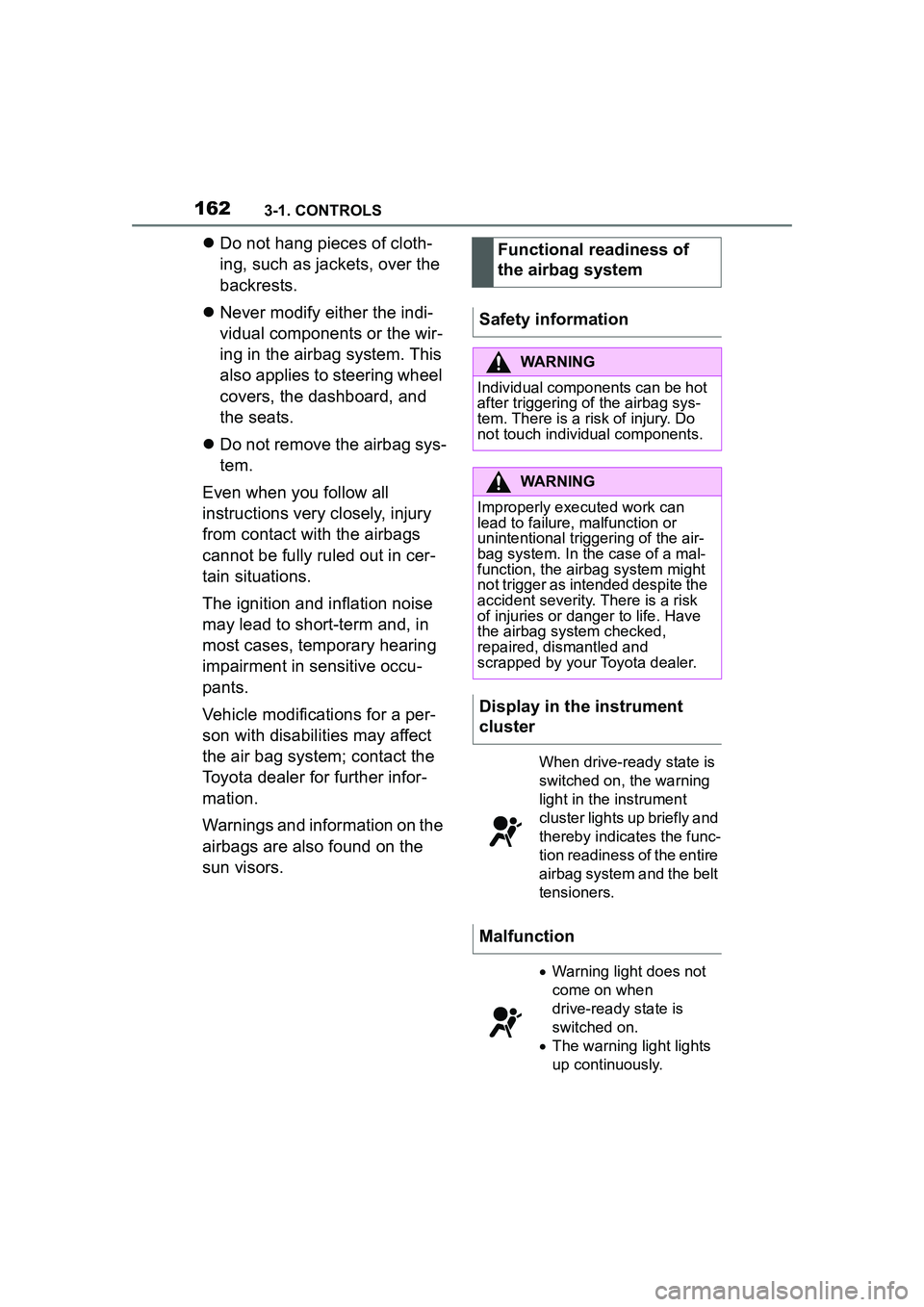
1623-1. CONTROLS
Do not hang pieces of cloth-
ing, such as jackets, over the
backrests.
Never modify either the indi-
vidual components or the wir-
ing in the airbag system. This
also applies to steering wheel
covers, the dashboard, and
the seats.
Do not remove the airbag sys-
tem.
Even when you follow all
instructions very closely, injury
from contact with the airbags
cannot be fully ruled out in cer-
tain situations.
The ignition and inflation noise
may lead to short-term and, in
most cases, temporary hearing
impairment in sensitive occu-
pants.
Vehicle modifications for a per-
son with disabilities may affect
the air bag system; contact the
Toyota dealer for further infor-
mation.
Warnings and information on the
airbags are also found on the
sun visors. Functional readiness of
the airbag system
Safety information
WARNING
Individual components can be hot
after triggering of the airbag sys-
tem. There is a risk of injury. Do
not touch individual components.
WARNING
Improperly executed work can
lead to failure, malfunction or
unintentional triggering of the air-
bag system. In the case of a mal-
function, the airbag system might
not trigger as intended despite the
accident severity. There is a risk
of injuries or danger to life. Have
the airbag system checked,
repaired, dismantled and
scrapped by your Toyota dealer.
Display in the instrument
cluster
When drive-ready state is
switched on, the warning
light in the instrument
cluster lights up briefly and
thereby indicates the func-
tion readiness of the entire
airbag system and the belt
tensioners.
Malfunction
Warning light does not
come on when
drive-ready state is
switched on.
The warning light lights
up continuously.
Page 163 of 356
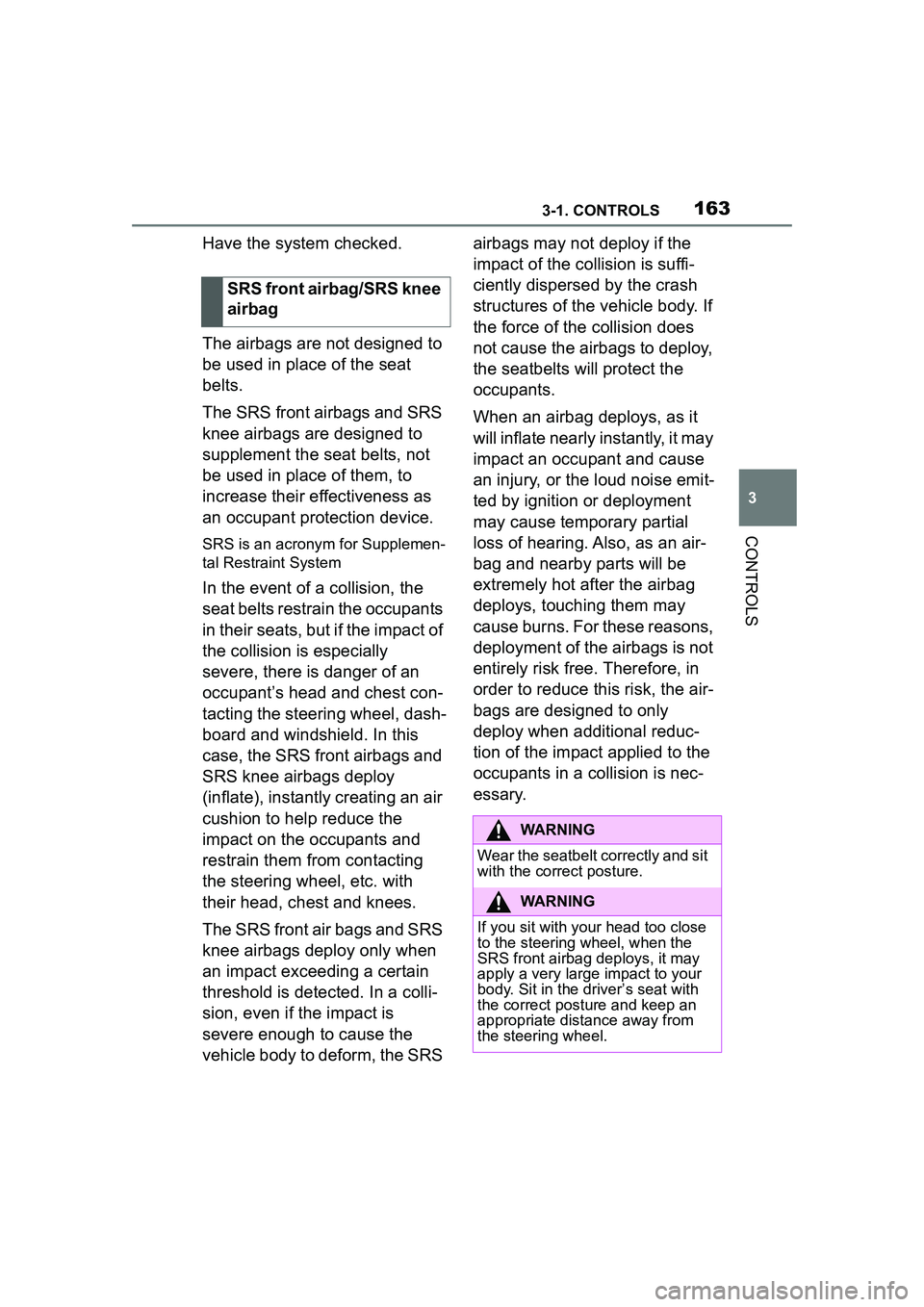
1633-1. CONTROLS
3
CONTROLS
Have the system checked.
The airbags are not designed to
be used in place of the seat
belts.
The SRS front airbags and SRS
knee airbags are designed to
supplement the seat belts, not
be used in place of them, to
increase their effectiveness as
an occupant protection device.
SRS is an acronym for Supplemen-
tal Restraint System
In the event of a collision, the
seat belts restrain the occupants
in their seats, but if the impact of
the collision is especially
severe, there is danger of an
occupant’s head and chest con-
tacting the steering wheel, dash-
board and windshield. In this
case, the SRS front airbags and
SRS knee airbags deploy
(inflate), instantly creating an air
cushion to help reduce the
impact on the occupants and
restrain them from contacting
the steering wheel, etc. with
their head, chest and knees.
The SRS front air bags and SRS
knee airbags deploy only when
an impact exceeding a certain
threshold is detected. In a colli-
sion, even if the impact is
severe enough to cause the
vehicle body to deform, the SRS airbags may not deploy if the
impact of the collision is suffi-
ciently dispersed by the crash
structures of the vehicle body. If
the force of the collision does
not cause the airbags to deploy,
the seatbelts will protect the
occupants.
When an airbag deploys, as it
will inflate nearly instantly, it may
impact an occupant and cause
an injury, or the loud noise emit-
ted by ignition or deployment
may cause temporary partial
loss of hearing. Also, as an air-
bag and nearby parts will be
extremely hot after the airbag
deploys, touching them may
cause burns. For these reasons,
deployment of the airbags is not
entirely risk free. Therefore, in
order to reduce this risk, the air-
bags are designed to only
deploy when additional reduc-
tion of the impact applied to the
occupants in a collision is nec-
essary.
SRS front airbag/SRS knee
airbag
WARNING
Wear the seatbelt correctly and sit
with the correct posture.
WARNING
If you sit with your head too close
to the steering wheel, when the
SRS front airbag deploys, it may
apply a very large impact to your
body. Sit in the driver’s seat with
the correct posture and keep an
appropriate distance away from
the steering wheel.
Page 164 of 356
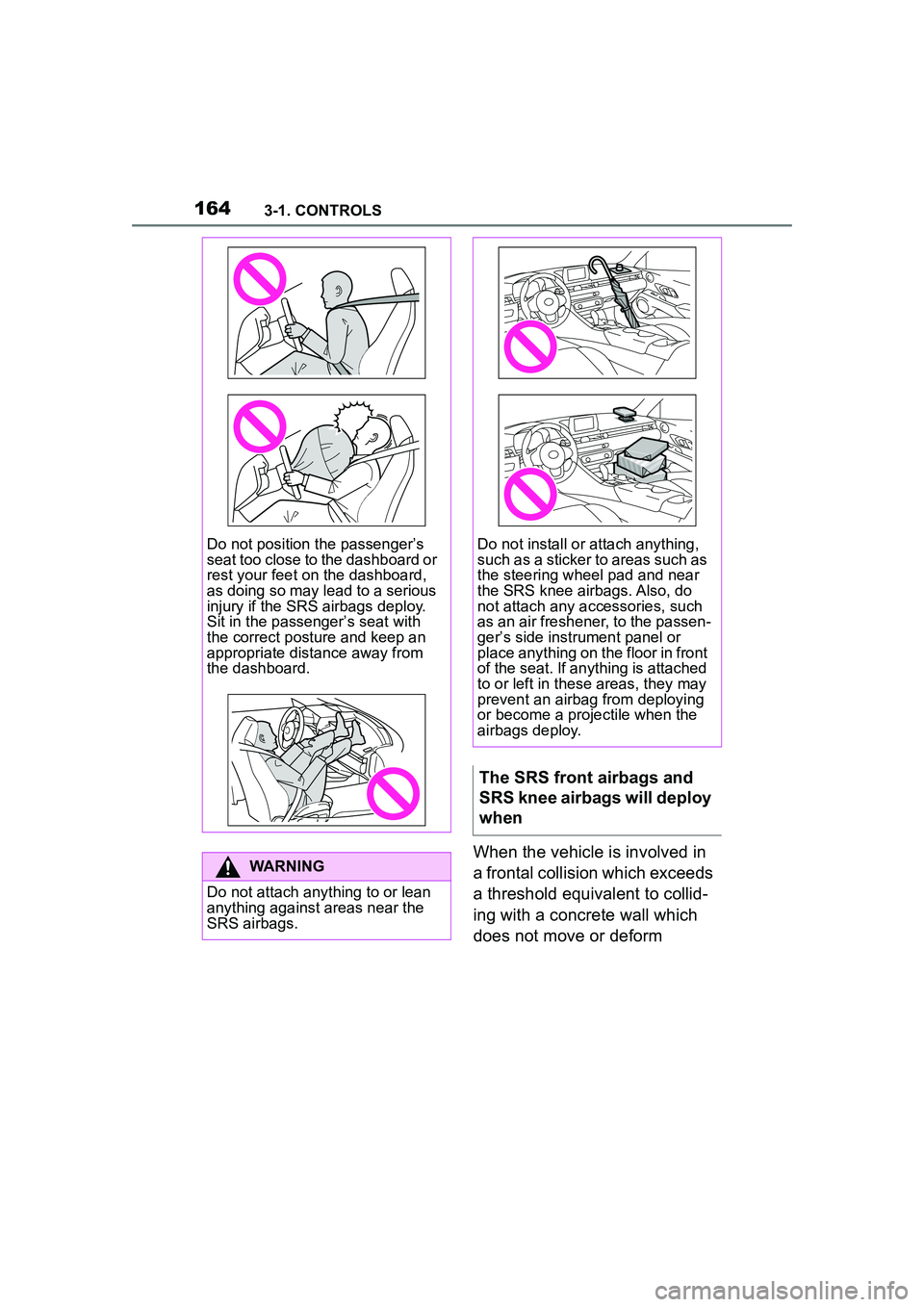
1643-1. CONTROLS
When the vehicle is involved in
a frontal collision which exceeds
a threshold equivalent to collid-
ing with a concrete wall which
does not move or deform
Do not position the passenger’s
seat too close to the dashboard or
rest your feet on the dashboard,
as doing so may lead to a serious
injury if the SRS airbags deploy.
Sit in the passenger’s seat with
the correct posture and keep an
appropriate distance away from
the dashboard.
WARNING
Do not attach anything to or lean
anything against areas near the
SRS airbags.
Do not install or attach anything,
such as a sticker to areas such as
the steering wheel pad and near
the SRS knee airbags. Also, do
not attach any accessories, such
as an air freshener, to the passen-
ger’s side instrument panel or
place anything on the floor in front
of the seat. If anything is attached
to or left in these areas, they may
prevent an airbag from deploying
or become a projectile when the
airbags deploy.
The SRS front airbags and
SRS knee airbags will deploy
when
Page 165 of 356
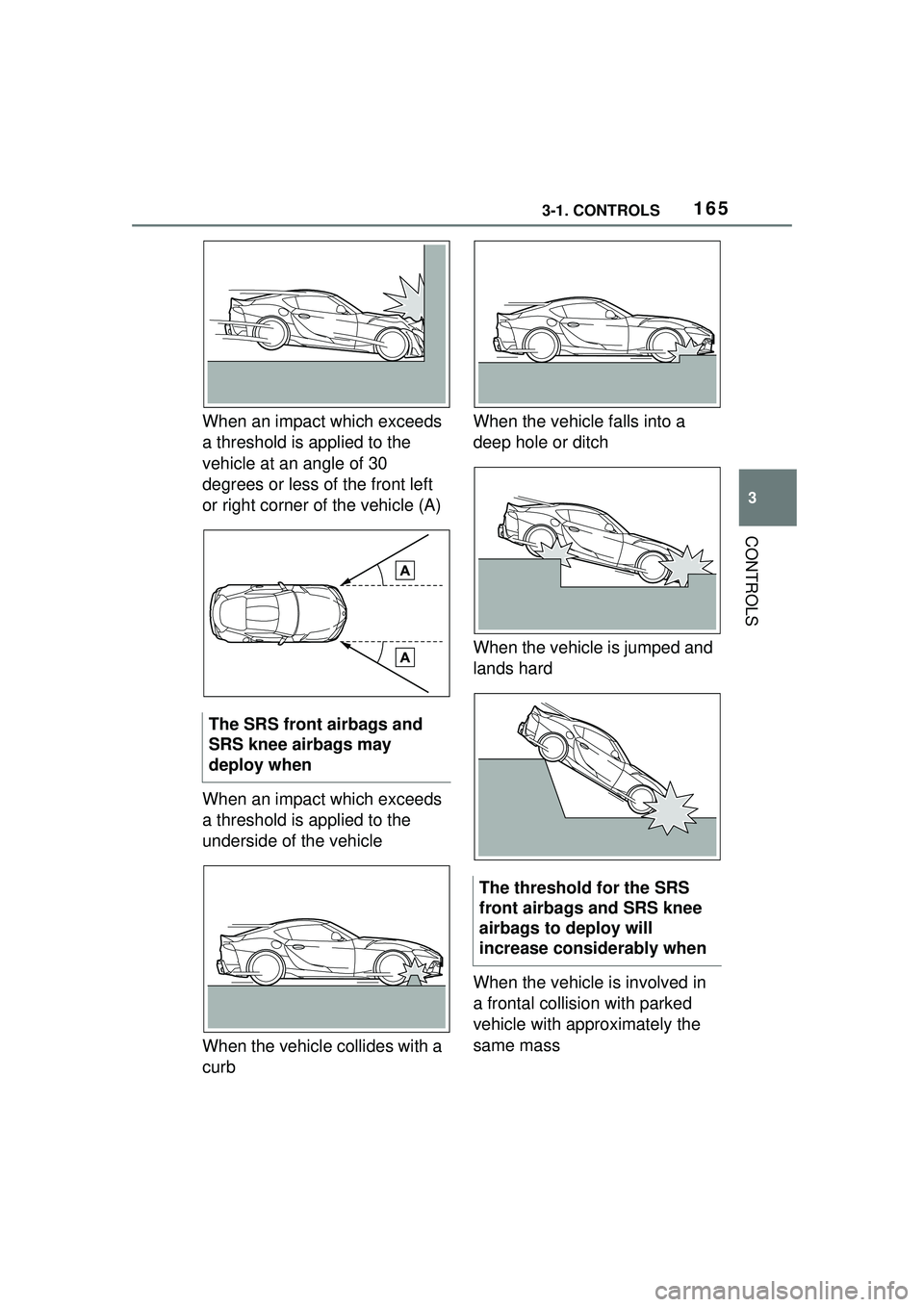
1653-1. CONTROLS
3
CONTROLS
When an impact which exceeds
a threshold is applied to the
vehicle at an angle of 30
degrees or less of the front left
or right corner of the vehicle (A)
When an impact which exceeds
a threshold is applied to the
underside of the vehicle
When the vehicle collides with a
curbWhen the vehicle falls into a
deep hole or ditch
When the vehicle is jumped and
lands hard
When the vehicle is involved in
a frontal collision with parked
vehicle with approximately the
same mass
The SRS front airbags and
SRS knee airbags may
deploy when
The threshold for the SRS
front airbags and SRS knee
airbags to deploy will
increase considerably when
Page 166 of 356
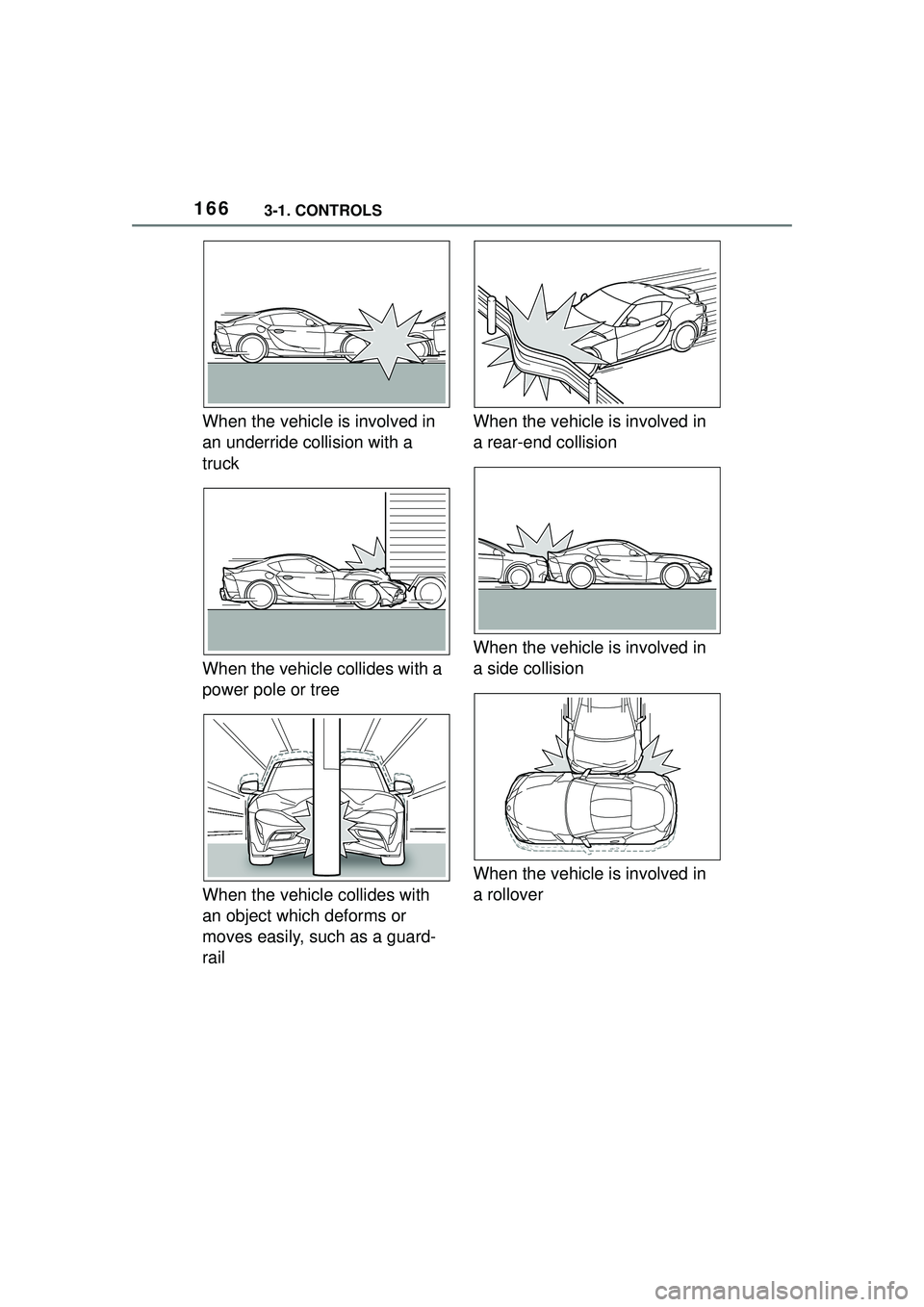
1663-1. CONTROLS
When the vehicle is involved in
an underride collision with a
truck
When the vehicle collides with a
power pole or tree
When the vehicle collides with
an object which deforms or
moves easily, such as a guard-
railWhen the vehicle is involved in
a rear-end collision
When the vehicle is involved in
a side collision
When the vehicle is involved in
a rollover
Page 167 of 356
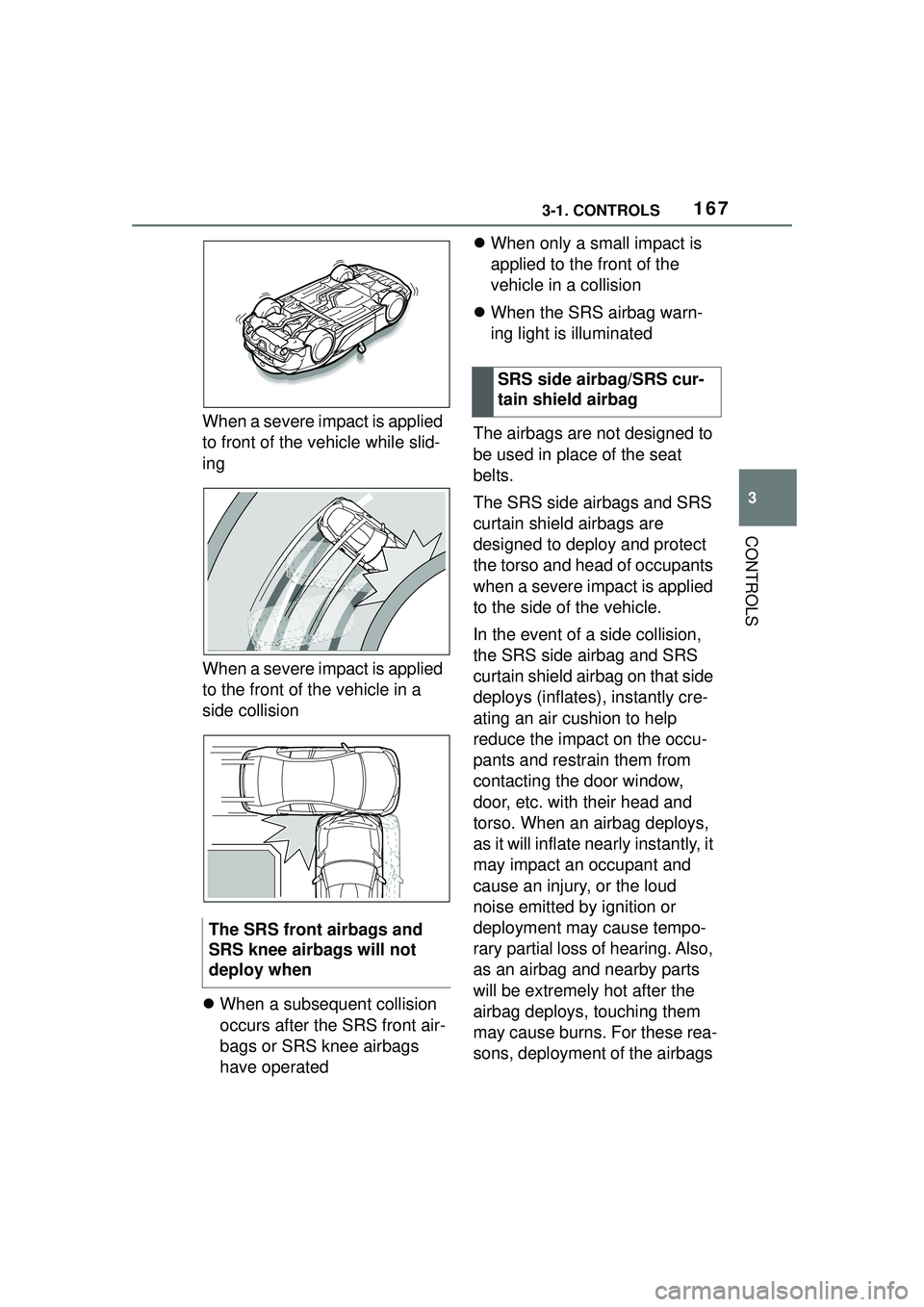
1673-1. CONTROLS
3
CONTROLS
When a severe impact is applied
to front of the vehicle while slid-
ing
When a severe impact is applied
to the front of the vehicle in a
side collision
When a subsequent collision
occurs after the SRS front air-
bags or SRS knee airbags
have operated
When only a small impact is
applied to the front of the
vehicle in a collision
When the SRS airbag warn-
ing light is illuminated
The airbags are not designed to
be used in place of the seat
belts.
The SRS side airbags and SRS
curtain shield airbags are
designed to deploy and protect
the torso and head of occupants
when a severe impact is applied
to the side of the vehicle.
In the event of a side collision,
the SRS side airbag and SRS
curtain shield airbag on that side
deploys (inflates), instantly cre-
ating an air cushion to help
reduce the impact on the occu-
pants and restrain them from
contacting the door window,
door, etc. with their head and
torso. When an airbag deploys,
as it will inflate nearly instantly, it
may impact an occupant and
cause an injury, or the loud
noise emitted by ignition or
deployment may cause tempo-
rary partial loss of hearing. Also,
as an airbag and nearby parts
will be extremely hot after the
airbag deploys, touching them
may cause burns. For these rea-
sons, deployment of the airbags
The SRS front airbags and
SRS knee airbags will not
deploy when
SRS side airbag/SRS cur-
tain shield airbag
Page 168 of 356
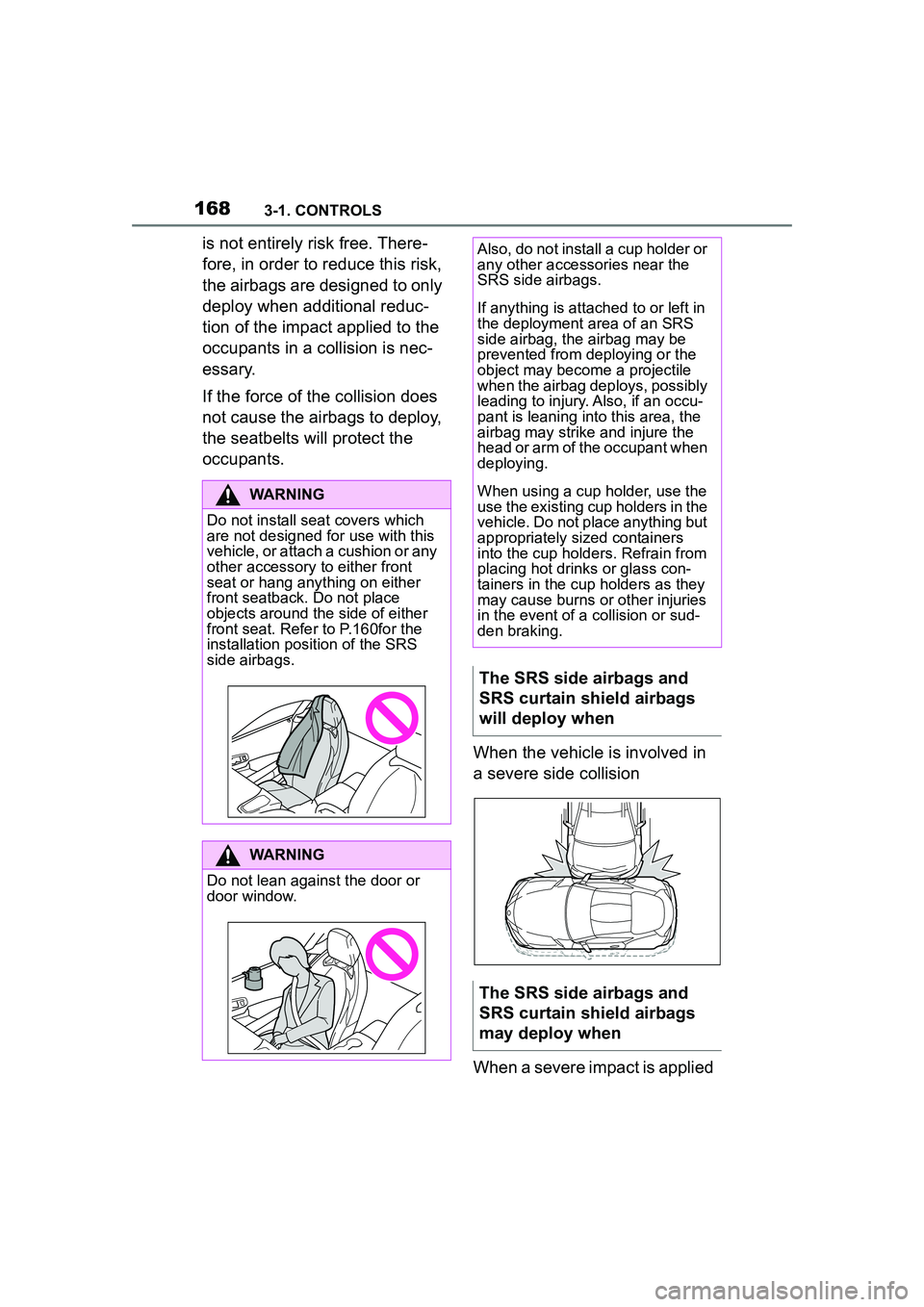
1683-1. CONTROLS
is not entirely risk free. There-
fore, in order to reduce this risk,
the airbags are designed to only
deploy when additional reduc-
tion of the impact applied to the
occupants in a collision is nec-
essary.
If the force of the collision does
not cause the airbags to deploy,
the seatbelts will protect the
occupants.When the vehicle is involved in
a severe side collision
When a severe impact is applied
WARNING
Do not install seat covers which
are not designed for use with this
vehicle, or attach a cushion or any
other accessory to either front
seat or hang anything on either
front seatback. Do not place
objects around the side of either
front seat. Refer to P.160for the
installation position of the SRS
side airbags.
WARNING
Do not lean against the door or
door window.
Also, do not install a cup holder or
any other accessories near the
SRS side airbags.
If anything is attached to or left in
the deployment area of an SRS
side airbag, the airbag may be
prevented from deploying or the
object may become a projectile
when the airbag deploys, possibly
leading to injury. Also, if an occu-
pant is leaning into this area, the
airbag may strike and injure the
head or arm of the occupant when
deploying.
When using a cup holder, use the
use the existing cup holders in the
vehicle. Do not place anything but
appropriately sized containers
into the cup holder s. Refrain from
placing hot drinks or glass con-
tainers in the cup holders as they
may cause burns or other injuries
in the event of a collision or sud-
den braking.
The SRS side airbags and
SRS curtain shield airbags
will deploy when
The SRS side airbags and
SRS curtain shield airbags
may deploy when
Page 169 of 356
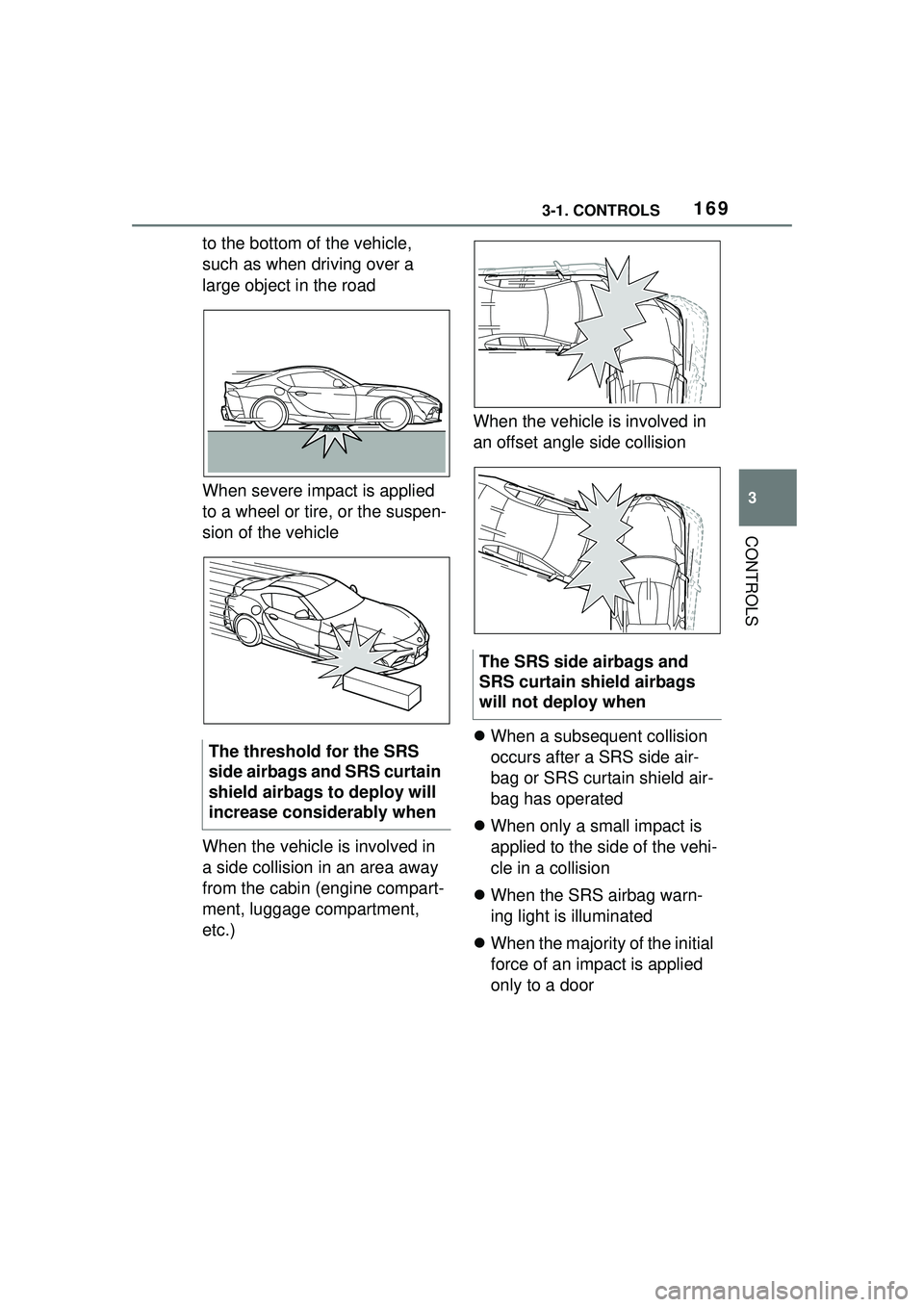
1693-1. CONTROLS
3
CONTROLS
to the bottom of the vehicle,
such as when driving over a
large object in the road
When severe impact is applied
to a wheel or tire, or the suspen-
sion of the vehicle
When the vehicle is involved in
a side collision in an area away
from the cabin (engine compart-
ment, luggage compartment,
etc.)When the vehicle is involved in
an offset angle side collision
When a subsequent collision
occurs after a SRS side air-
bag or SRS curtain shield air-
bag has operated
When only a small impact is
applied to the side of the vehi-
cle in a collision
When the SRS airbag warn-
ing light is illuminated
When the majority of the initial
force of an impact is applied
only to a door
The threshold for the SRS
side airbags and SRS curtain
shield airbags to deploy will
increase considerably when
The SRS side airbags and
SRS curtain shield airbags
will not deploy when
Page 170 of 356
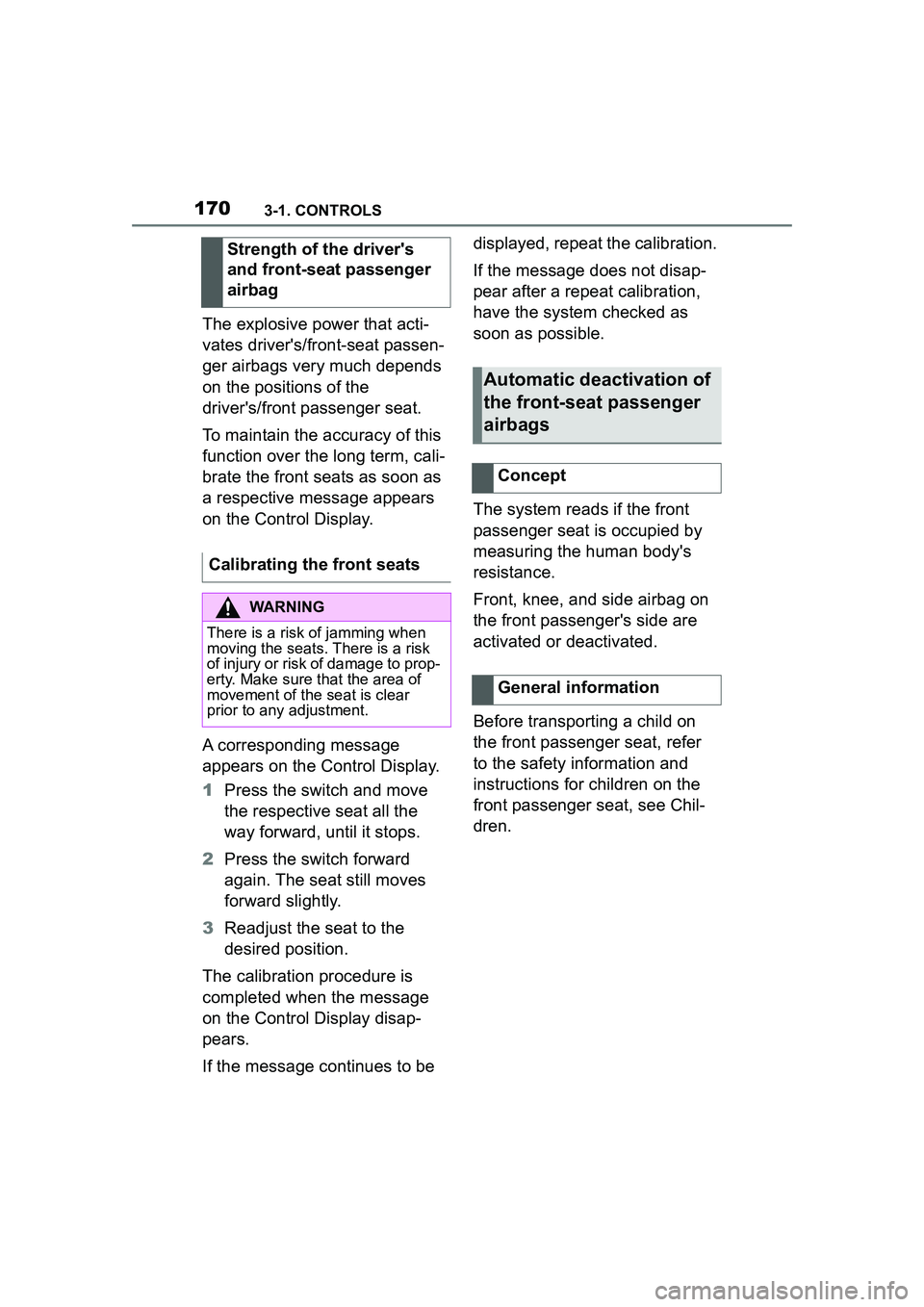
1703-1. CONTROLS
The explosive power that acti-
vates driver's/front-seat passen-
ger airbags very much depends
on the positions of the
driver's/front passenger seat.
To maintain the accuracy of this
function over the long term, cali-
brate the front seats as soon as
a respective message appears
on the Control Display.
A corresponding message
appears on the Control Display.
1Press the switch and move
the respective seat all the
way forward, until it stops.
2 Press the switch forward
again. The seat still moves
forward slightly.
3 Readjust the seat to the
desired position.
The calibration procedure is
completed when the message
on the Control Display disap-
pears.
If the message continues to be displayed, repeat the calibration.
If the message does not disap-
pear after a repeat calibration,
have the system checked as
soon as possible.
The system reads if the front
passenger seat is occupied by
measuring the human body's
resistance.
Front, knee, and side airbag on
the front passenger's side are
activated or deactivated.
Before transporting a child on
the front passenger seat, refer
to the safety information and
instructions for children on the
front passenger seat, see Chil-
dren.
Strength of the driver's
and front-seat passenger
airbag
Calibrating the front seats
WARNING
There is a risk of jamming when
moving the seats. There is a risk
of injury or risk of damage to prop-
erty. Make sure that the area of
movement of the seat is clear
prior to any adjustment.
Automatic deactivation of
the front-seat passenger
airbags
Concept
General information